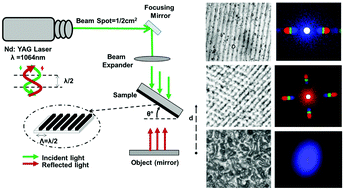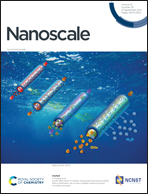Strain -multiplexing optical-tuning based on single-pulsed holographic nanostructures†
Abstract
Holographic flexible and rigid nanostructures in the visible to near infrared range play vital roles in various applications, including displays, data storage, imaging, and security. However, personalized use of holography is limited due to the time-consuming, costly and complex nanofabrication procedures. Personalized holography can be improved/extended through rapid, efficient and low-cost techniques on rigid, flexible and edible materials. Here, we utilize a single-pulsed nanosecond (ns) laser ablation in Denisyuk reflection mode to record one/two-dimension (1/2D) nanostructures on various substrates, including rigid glass coated with soft polymers, gelatin, and conductive (gold) and non-conductive materials (ink) as holographic multilayer metastructures (HMMs). The tunability of optical properties was investigated by illuminating monochromatic and broadband light sources on flexible-template nanostructures. The surface morphologies of the nano-structures were changed by applying mechanical force, which in turn tuned the far-field optical response depending upon the amount of applied force, acting as an optical shape and force sensor. Nanostructures engineered on an edible material (gelatin) as well as on soft polymers (polymeric diffusers) were also demonstrated for suitable application in food industries and optoelectronics.



 Please wait while we load your content...
Please wait while we load your content...